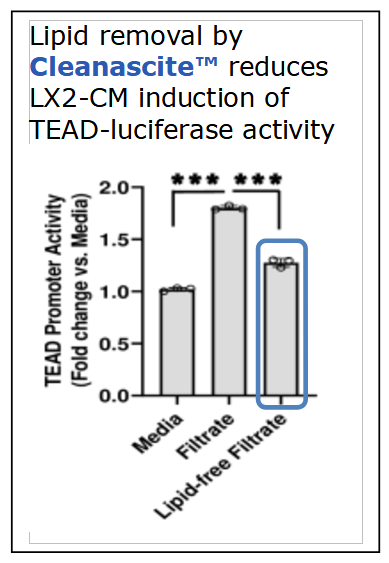|
Cleanascite™ Employed To Investigate Lipid Pathway Influences on Hepatocellular Carcinoma Biotech Support Group reports on an article, describing the simplicity and efficiency of their lipid binding technology to determine the influence of lipid LTB4R2 ligands within pathways associated with Hepatocellular carcinoma. News Release
Cleanascite™ Employed To Investigate Lipid Pathway Influences on Hepatocellular Carcinoma
MONMOUTH JUNCTION, NJ , May 11, 2023 -- Biotech Support Group reports on an article, describing the simplicity and efficiency of their lipid binding technology to determine the influence of lipid LTB4R2 ligands within pathways associated with Hepatocellular carcinoma.
“ This is another example of many studies, whereby Cleanascite™ was used in evaluating the removal of fatty acids for in vitro cancer models. These references show that Cleanascite™ can help identify a characteristic feature of cell response related to lipid removal. Unlike alternative lipid-removal methods that either use solvents, or bind non-specifically to important growth factors, Cleanascite™ is an aqueous suspension product with excellent selectivity for lipids, and so post-treatment, it seamlessly integrates with cellular models of disease. This ultimately helps with investigations such as this, that need to determine whether or not lipids, or factors associated with lipids, impart phenotypic changes to cells.” states Swapan Roy, Ph.D., President and Founder of Biotech Support Group. Link to view our case study, Lipid Removal for Phenotypic Cell Response in Cancer Research (biotechsupportgroup.com)
For
more information visit:
Cleanascite™
Lipid Removal Reagent and Clarification,
at
Keywords: Hepatocellular carcinoma , long-chain fatty acids, 12-hydroxyheptadecatrienoic acid, lipid removal, activated hepatic stellate cells , leukotriene B4 receptor 2 ligands , Cleanascite™
For Business Development , contact: Matthew Kuruc 732-274-2866, mkuruc@biotechsupportgroup.com
|

- About
- Products
- Hemoglobin Removal Kits
- Lipid Removal & Clarification
- Urine Protein & Low Abundance Enrichment
- Class Specific Enrichment
- Sample Prep Mass Spectrometry
- Functional & Chemical Proteomics
- Genomic Sample Prep
- Accessories
- Technical Resources
- References
- Publications & Reports
- FAQs
- Case Studies
- Cleanascite™ Unlocks Insights into Lipid-Driven Tumor Immunosuppression
- NRicher™ Bead Platform Provides Unique Sub-Proteome Biases And Fit For Purpose Opportunities for Targeted LC-MS Quantification
- BSG Products To Assist in Analyzing Macrophage Polarization
- Ectodomain Shedding and Enrichment of the Soluble Membrane Proteome
- Investigate out of the Venn Diagram box
- Methods to selectively deplete or purify Hemoglobin from Dried Blood Spots (DBS)
- The Utility of HemoVoid™ is Demonstrated in 3 Proteomic Investigations Identifying Potential Disease Specific Biomarkers
- The 4 common features of our sample prep products, known as the BSG Advantage, are highlighted in a selection of journal references.
- AlbuVoid™ Workflows Advance Cell Secretome Proteomics
- Lipid Removal for Phenotypic Cell Response in Cancer Research
- The Influence of Sample Prep Bias on LC-MS Targeted Peptide Quantification in Serum Proteomics
- Re-imagining proteomics for developing precision medicine biomarkers of the innate immune response in SARS-CoV-2
- Patent Application Describes New Proteomic Methods to Monitor Protease Inhibitor Function During Covid-19 Infections
- Efficient Hemoglobin Removal Advances Red Cell Proteomics Offering Many New Insights Into Inflammation and Infectious Disease
- The Potential for New Blood Biomarkers in the Management of COVID-19 Disease
- Establishing the Utility of HemoVoid™ and HemogloBind™ as Enrichment Tools for Proteomic Analysis of Red Cells and Whole Blood in Parkinson’s Disease
- Species Diversity Supported By BSG Products
- Poster Report Describes Loss of Functional Serpin Activity In Cancer Patient Blood
- AlbuVoid™️ PLUS & AlbuSorb™️ PLUS Evaluating Different Windows of Observation Solves The Many Challenges of Serum Proteomics
- Tackling the Challenges of Serum Proteomics
- Lipid Removal Sample Prep for Cell Response Applications
- Sample Prep for Proteomic Analysis of Saliva
- Biotech Support Group Featured in Book, "Functional Proteomics – Methods and Protocols"
- Sample Prep Liquid Biopsy Products Suitable for Proteomic Profiling of a Variety of Body Fluid Sample Types
- Albumin and High Abundance Depletion
- Using HemogloBind™ as a Hemoglobin Binding Reagent
- Diverse technologies available for researchers to selectively bind or enrich exosomes and extracellular vesicles.
- Stroma Liquid Biopsy™ Biomarkers Profile Pan-Cancer Dysregulation of the Serum Proteome
- Diverse Depletion and Enrichment Technologies Enhance Simplicity and Efficiency of Obtaining Quality Proteomic Information
- Use On-Bead Digestion to Improve Time Required for Serum Digestion
- Using AlbuVoid™ as a Serum Protein Enrichment Kit in Functional Proteomics
- Using Cleanascite™ as a Lipid Absorption and Clarification Reagent
- Using HemoVoid to Remove Hemoglobin Before Analysis
- Blog
- Contact
- Liquid Biopsy

